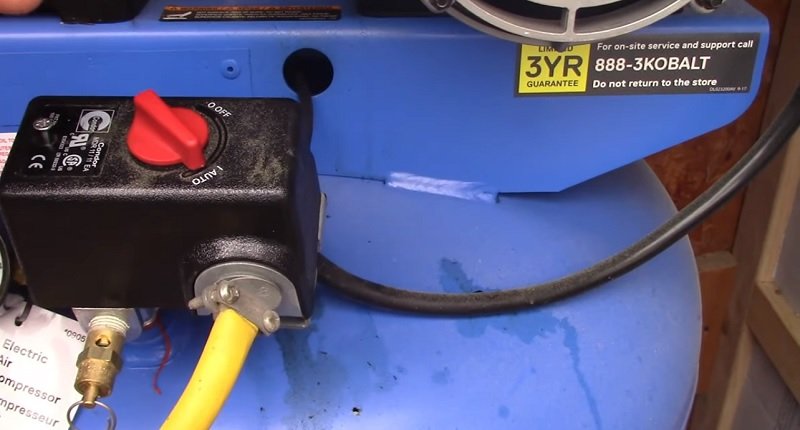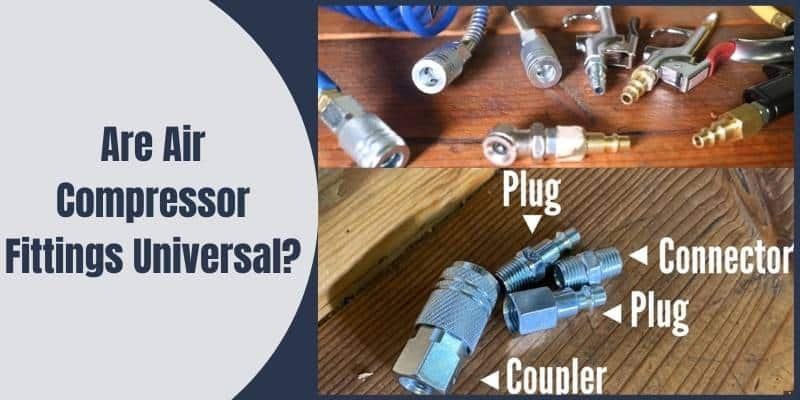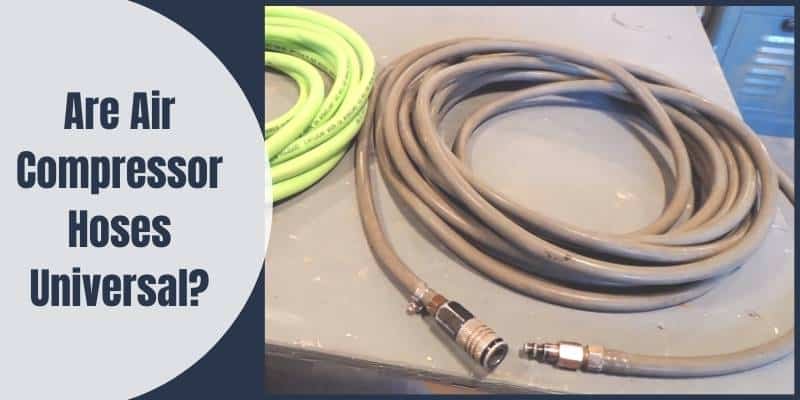Disclosure: This post contains affiliate links and I will be compensated if you make a purchase after clicking through my links. Learn More
Do Air Compressors Shut Off Automatically? Discover the time-saving wonders of air compressors with their smart automatic shut-off feature! In this guide, we’ll explore how these nifty devices can handle pressure like a pro, ensuring safety and convenience for all your pneumatic needs. Get ready to unleash the power of automation and say goodbye to manual monitoring!

Do Air Compressors Shut Off Automatically?
Yes, air compressors often have built-in pressure switches that automatically shut off the compressor when the desired pressure level is reached, and they will turn back on when the pressure drops below a certain threshold. This automatic feature ensures safety and efficiency in their operation.
Automatic Shut Off Feature
An automatic shut off feature is a common safety feature found in most air compressors. This feature is designed to prevent the machine from overheating and causing damage or injury.
When the air compressor reaches a certain temperature or pressure, the automatic shut off feature will activate and turn off the machine. This prevents the compressor from continuing to run and potentially causing damage or injury.
The automatic shut off feature is typically controlled by a pressure switch or temperature sensor. The pressure switch monitors the air pressure in the tank and will shut off the compressor when it reaches a predetermined level. The temperature sensor monitors the temperature of the compressor and will shut off the machine if it gets too hot.
It’s important to note that the automatic shut off feature is not a substitute for proper maintenance and operation of the air compressor. Regular maintenance, such as changing the oil and cleaning the air filter, can help prevent overheating and prolong the life of the compressor.
Overall, the automatic shut off feature is an important safety feature that helps prevent damage or injury caused by overheating. By ensuring that your air compressor has this feature and properly maintaining it, you can use your compressor with confidence and peace of mind.
How Does Automatic Shut Off Work?

When it comes to air compressors, automatic shut off is a crucial feature that ensures the safety of both the compressor and the user. The automatic shut off function is designed to turn off the compressor when it reaches a certain pressure level, preventing it from overworking and potentially causing damage or injury.
The automatic shut off function works by using a pressure switch. The pressure switch is a device that is connected to the compressor tank and monitors the air pressure inside. When the pressure reaches a certain level, the switch is triggered, and it sends a signal to the compressor to shut off.
The pressure switch is typically set to turn off the compressor when the pressure reaches a certain level, known as the cut-out pressure. The cut-out pressure is usually set slightly above the maximum pressure that the compressor is designed to handle. This ensures that the compressor never reaches a pressure level that could cause damage or injury.
In addition to the cut-out pressure, the pressure switch also has a cut-in pressure. The cut-in pressure is the pressure level at which the compressor will turn back on after it has shut off. This pressure level is usually set slightly below the cut-out pressure, so the compressor will turn on before the pressure drops too low.
Overall, the automatic shut off function is a vital safety feature for air compressors. It works by using a pressure switch to monitor the air pressure inside the tank and turn off the compressor when it reaches a certain level. This ensures that the compressor never overworks and prevents potential damage or injury.
Pressure Switch in Air Compressors
When you turn on your air compressor, the motor starts running and the pressure inside the tank starts increasing. The pressure switch is responsible for monitoring the pressure inside the tank and turning off the motor when the pressure reaches a certain level.
The pressure switch is a critical component of an air compressor, as it ensures that the compressor doesn’t over-pressurize and cause damage to itself or any connected devices. It also prevents the compressor from running continuously, which can lead to overheating and other problems.
Most pressure switches are adjustable, which means you can set the pressure at which the switch will turn off the motor. This allows you to customize the pressure to meet your specific needs. Some pressure switches also have a built-in safety valve, which will release pressure if the pressure switch fails or if the pressure in the tank becomes too high.
If you’re experiencing issues with your air compressor, such as the motor not turning off or the pressure not reaching the desired level, it’s possible that the pressure switch is faulty or needs to be adjusted. It’s important to consult the manufacturer’s instructions or a professional technician to ensure that you’re making the proper adjustments and maintaining the safety of your equipment.
Overall, the pressure switch is a crucial component of an air compressor that ensures safe and efficient operation. By understanding how it works and how to properly adjust it, you can keep your air compressor running smoothly and avoid costly repairs or replacements.
Understanding the Pressure Switch Functionality
When it comes to air compressors, the pressure switch plays a crucial role in ensuring that the compressor works efficiently and safely. The pressure switch is responsible for monitoring the air pressure inside the compressor tank and turning the compressor on and off as needed to maintain the desired pressure.
Here’s how it works: when you turn on the compressor, the pressure switch senses the air pressure inside the tank. If the pressure is below the set level, the switch will turn on the compressor motor, which will start pumping air into the tank. As the pressure in the tank builds up, the switch will eventually sense that the pressure has reached the desired level and turn off the motor.
Once the pressure drops below the set level again, the switch will turn the motor back on and the cycle will start all over again. This automatic on/off cycling is what allows air compressors to maintain a consistent air pressure without the need for constant manual adjustments.
It’s important to note that pressure switches are not all created equal. Different switches have different pressure ranges and set points, so it’s important to choose the right switch for your compressor’s needs. Additionally, pressure switches can wear out over time and may need to be replaced periodically to ensure proper functionality.
Overall, understanding the pressure switch functionality is essential for anyone who uses an air compressor. By ensuring that your compressor’s pressure switch is working properly and choosing the right switch for your needs, you can ensure that your compressor operates safely and efficiently.
Importance of Automatic Shut Off
When it comes to air compressors, safety is of the utmost importance. One key safety feature is the automatic shut off. This feature ensures that the compressor stops running when it reaches a certain pressure level, preventing the risk of over-pressurization.
Without an automatic shut off, an air compressor could continue to run indefinitely, leading to overheating, equipment damage, and even explosions. This can be particularly dangerous in industrial settings where large compressors are used.
In addition to safety, an automatic shut off can also save you money. By preventing the compressor from running unnecessarily, it can help reduce energy costs and extend the lifespan of the equipment.
Overall, an automatic shut off is a crucial feature for any air compressor. It provides peace of mind knowing that the equipment is operating safely and efficiently.
Types of Air Compressors with Automatic Shut Off
When it comes to air compressors, there are a variety of types available on the market. Some of these types come with automatic shut off features that can help you save energy and prevent damage to your compressor. Here are a few types of air compressors with automatic shut off:
Reciprocating Air Compressors
Reciprocating air compressors are one of the most common types of air compressors available on the market. These compressors use pistons to compress air and store it in a tank.
They can come with an automatic shut off feature that turns off the compressor when the tank reaches a certain pressure level. This can help prevent damage to the compressor and save energy.
Rotary Screw Air Compressors
Rotary screw air compressors are another popular type of air compressor. These compressors use two rotating screws to compress air and store it in a tank.
They can also come with an automatic shut off feature that turns off the compressor when the tank reaches a certain pressure level. This can help prevent damage to the compressor and save energy.
Centrifugal Air Compressors
Centrifugal air compressors are typically used in large industrial settings. These compressors use a spinning impeller to compress air and do not store air in a tank.
They can also come with an automatic shut off feature that turns off the compressor when the pressure reaches a certain level.
Overall, air compressors with automatic shut off features can be a great investment for those looking to save energy and prevent damage to their compressors. Make sure to do your research and choose the right type of compressor for your specific needs.
Troubleshooting Automatic Shut Off Issues
If your air compressor is not shutting off automatically, there could be a few issues that you need to troubleshoot. Here are some common problems and solutions to help you fix the issue:
1. Pressure Switch Malfunction
The pressure switch is responsible for turning the compressor on and off as needed. If the switch is faulty, it can cause the compressor to run continuously or not shut off at all.
You can check the switch by disconnecting the power and removing the cover to inspect the contacts. If they are dirty or corroded, clean them with a wire brush or replace the switch altogether.
2. Leaks in the System
If there are leaks in the air compressor system, it can cause the compressor to run continuously to compensate for the loss of pressure.
Check all the connections, hoses, and fittings for any signs of leaks. You can use a soapy water solution to detect leaks by applying it to the connections and looking for bubbles. If you find any leaks, tighten the connections or replace the damaged parts.
3. Clogged Filters
Air filters are responsible for removing impurities from the air before it enters the compressor. Over time, the filters can become clogged with dirt and debris, causing the compressor to work harder to maintain pressure. Check the filters and clean or replace them as needed.
4. Incorrect Pressure Settings
If the pressure settings on your compressor are incorrect, it can cause the compressor to shut off prematurely or not at all.
Check the manual for the correct pressure settings and adjust them accordingly. You can also check the pressure gauge to ensure it is reading accurately.
By troubleshooting these common issues, you can get your air compressor to shut off automatically again. Remember to always follow safety precautions when working with air compressors, and consult a professional if you are unsure about any repairs.
Maintaining an Air Compressor’s Automatic Shut Off
To ensure that your air compressor’s automatic shut off feature is working properly, it is important to perform regular maintenance. Here are some steps you can take to maintain this feature:
Check the pressure switch: The pressure switch is responsible for turning the compressor on and off at the appropriate pressure. Over time, the contacts inside the switch can become dirty or worn, causing the switch to malfunction. To prevent this, inspect the switch regularly and clean it if necessary.
Inspect the safety valve: The safety valve is designed to release pressure from the compressor if the pressure switch fails or the pressure becomes too high. If the safety valve is damaged or malfunctioning, it can prevent the compressor from shutting off automatically. Check the valve regularly and replace it if necessary.
Clean or replace the air filter: A dirty air filter can cause the compressor to overheat, which can lead to a malfunctioning pressure switch and prevent the compressor from shutting off automatically. Clean or replace the air filter regularly to prevent this.
Check the oil level: Low oil levels can cause the compressor to overheat, which can also lead to a malfunctioning pressure switch and prevent the compressor from shutting off automatically. Check the oil level regularly and add oil if necessary.
By following these simple steps, you can ensure that your air compressor’s automatic shut off feature is working properly and prevent any potential safety hazards.
Final Thoughts
Air compressors can shut off automatically. Many modern air compressors come with an automatic shut-off feature that turns off the compressor once it reaches a certain pressure level. This is a safety feature that prevents the compressor from over-pressurizing and causing damage or injury.
It is important to note that not all air compressors have this feature. If you are in the market for an air compressor, it is important to check the specifications to see if it has an automatic shut-off feature.
Additionally, it is important to properly maintain your air compressor to ensure that it continues to function properly. Regular maintenance can help prevent malfunctions and extend the lifespan of your compressor.
Overall, an automatic shut-off feature is a useful safety feature to have in an air compressor. It can help prevent accidents and prolong the life of your compressor.


